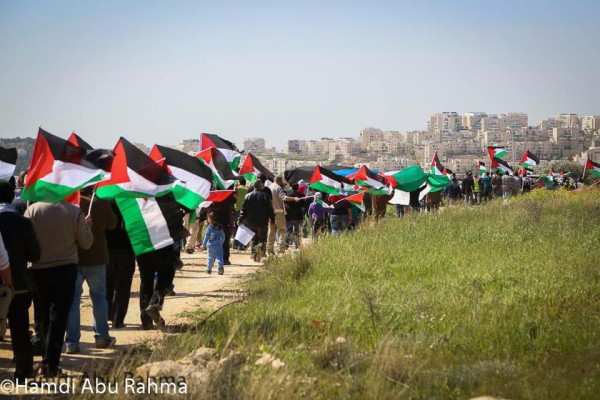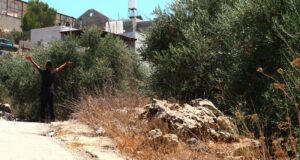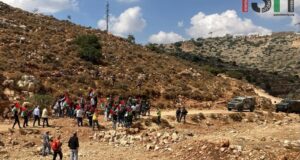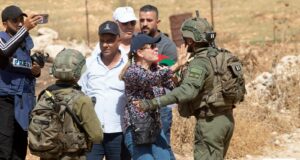2nd March | Abdallah Abu Rahma – originally posted on Haaretz | Bil’in, Occupied Palestine
On February 20, 2005, we, residents of the West Bank Palestinian village of Bil’in, set forth, accompanied by supporters from around the world, and marched to the west side of the village. Israeli army bulldozers had begun uprooting olive trees there and wiping out the place that had shaped our memories and those of our ancestors. The occupation regime provided the excuse that the wall that they were building there was for “security reasons,” but the truth was that the real aim was to steal land to build Jewish settlements. Since then, we have organized 521 weekly Friday demonstrations and another 80 at other times.
The protests are still taking place. We take pride not over the large number of protests that we have held but rather over the fact that we set a goal for ourselves and have accomplished it. We are simple people and are not large in number, but from the first moment, we refused to accept the reality the occupation was imposing on us through the separation barrier, with its route planned to run through Bil’in and neighboring villages. And despite the range of points of view of village residents, everyone agreed on a common goal: persistent opposition to the fence, until it came down.
Advancing toward our goal required us to cooperate like a hive of bees. The first step involved dividing up the tasks and areas of responsibility and pooling together resources and efforts. The recruitment of our friends from abroad in our struggle made things easier for us — as did the fact that Israeli activists joined us. The village residents, who had never met Israelis who were not soldiers or settlers, had a hard time accepting the Israelis’ involvement at first, but it soon became clear that bullets fired at demonstrations did not discriminate. They hit everyone, without distinction of religion, race or gender, and that held true when it came to arrests as well. Nevertheless, discrimination between Palestinian activists and Israelis and foreigners of course does exist in the military court system in the West Bank.
The second step in turning Bil’in into a symbol of the Palestinian popular struggle to such an extent that the villagers have been dubbed the “Palestinian Gandhis” was the use of art, theater, sports and music at the protests to illustrate the disaster that the construction of the fence was bringing upon us. Then came the third step: working with the media to convey the suffering of the Palestinians. We created a bridge of trust and credibility that bypassed the occupation authorities’ and IDF Spokesman’s stream of distortion and spin, telling our story to the Palestinian and international media, and sometimes to the Israeli media as well. We approached not only well-established media outlets, but also the alternative media and social media.
The fourth step involved devoting resources to legal battles — providing legal defense and assistance to detainees and aid in filing court petitions. We knew that the prospect that a court in Israel would accept the Palestinian position was slim, but through insistence and persistence, and concerted legal effort, we convinced the Israeli Supreme Court that our arguments were correct, that the route of the fence on Bil’in’s land was not decided based on security considerations, as the Israeli army had claimed, but rather in order to confiscate land and expand the settlements that were built on our land.
As a result, on July 3, 2007, the court ruled that the fence in Bil’in should be demolished. The execution of the court decision, albeit after major delays, delighted the village residents, but that was not the end of the story. The protests continued, with additional goals: rehabilitating the land that had been recovered, encouraging the villagers to establish a presence on it, by farming it again and by building recreational facilities on it to reestablish the connection between the residents and the land itself.
The fifth step involved continuity. Whatever the weather, in heat and cold, regardless of the circumstances, whether sad or happy, and despite the various kinds of collective punishment — the closure, the roadblocks, the curfews — we insisted on holding the demonstrations with our flag held high. One day people asked me why I always carried a Palestinian flag at the demonstrations, to which I replied that as long as the occupation continues, my flag will be held high as a symbol of the continued fight for liberation.
The Israeli army spared no effort to put down the demonstrations in Bil’in. It used various types of ammunition, some old and familiar, while others were tried here for the first time. They also demonstrated considerable creativity when it came to collective punishment. The army raised the use of nighttime raids into the village to a real art form. Hundreds of residents were arrested in the ten years of protest, and thousands were injured. Two people from one family, Bassem and Jawaher Abu Rahmeh, were killed by the army. None of this diverted us from our goal of liberating our land.
On this momentous occasion, after ten years of efforts, I was put on trial for a fifth time over a series of false allegations. This is also the fifth time that an Israeli judge has convicted me. Last time it led to 16 months in prison, but there is no punishment that can undermine my sense of the justice of my right to defend my land and my people’s land and our human rights. I will remain loyal to this struggle whatever the price.
Anyone who has tasted success and victory will always seek to repeat them and preserve them and will not be reconciled to any other reality. The price is steep, but the rewards come later, when you sense the joy, the security and the peace that your activities have provided for everyone. Failure and defeat sometimes make people evade responsibility and assign blame for their circumstances. There are also those who deal with defeat by assimilating the worldview of the victor and acceptance of the new reality. That is another reason why we cannot remain silent in the face of injustice. All of us much act to change the bitter reality.
The successes and achievements of the village of Bil’in are not exclusively that of one person but rather the result of a collective effort that everyone is entitled to take pride in — Palestinians, activists from abroad and Israeli activists. We therefore share our happiness with all of those who have come to Bil’in since 2005. We will continue to strive for humaneness to prevail. Even those who have not come to the village up to now are invited to join in and taste the sweetness of success.
Abdullah Abu Rahmeh is the coordinator of the Bil’in Popular Committee
 International Solidarity Movement Nonviolence. Justice. Freedom.
International Solidarity Movement Nonviolence. Justice. Freedom.



